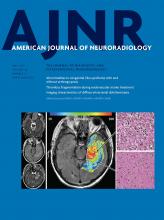Index by author
Blevins, G.
- Adult BrainOpen AccessCognitive Implications of Deep Gray Matter Iron in Multiple SclerosisE. Fujiwara, J.A. Kmech, D. Cobzas, H. Sun, P. Seres, G. Blevins and A.H. WilmanAmerican Journal of Neuroradiology May 2017, 38 (5) 942-948; DOI: https://doi.org/10.3174/ajnr.A5109
Blumenthal, D.T.
- Adult BrainOpen AccessClassification of High-Grade Glioma into Tumor and Nontumor Components Using Support Vector MachineD.T. Blumenthal, M. Artzi, G. Liberman, F. Bokstein, O. Aizenstein and D. Ben BashatAmerican Journal of Neuroradiology May 2017, 38 (5) 908-914; DOI: https://doi.org/10.3174/ajnr.A5127
Boardman, J.P.
- Pediatric NeuroimagingYou have accessBrain Development in Fetuses of Mothers with Diabetes: A Case-Control MR Imaging StudyF.C. Denison, G. Macnaught, S.I.K. Semple, G. Terris, J. Walker, D. Anblagan, A. Serag, R.M. Reynolds and J.P. BoardmanAmerican Journal of Neuroradiology May 2017, 38 (5) 1037-1044; DOI: https://doi.org/10.3174/ajnr.A5118
Bodanapally, U.K.
- Head and Neck ImagingYou have accessPrognostic Predictors of Visual Outcome in Open Globe Injury: Emphasis on Facial CT FindingsU.K. Bodanapally, H. Addis, D. Dreizin, A.K. Reddy, J.A. Margo, K.L. Archer-Arroyo, S. Feldman, B. Saboury, K. Sudini and O. SaeediAmerican Journal of Neuroradiology May 2017, 38 (5) 1013-1018; DOI: https://doi.org/10.3174/ajnr.A5107
Boeckh-behrens, T.
- EDITOR'S CHOICENeurointerventionYou have accessRisk of Thrombus Fragmentation during Endovascular Stroke TreatmentJ. Kaesmacher, T. Boeckh-Behrens, S. Simon, C. Maegerlein, J.F. Kleine, C. Zimmer, L. Schirmer, H. Poppert and T. HuberAmerican Journal of Neuroradiology May 2017, 38 (5) 991-998; DOI: https://doi.org/10.3174/ajnr.A5105
The authors evaluated the potential relationship between thrombus histology and clot stability in 85 patients with anterior circulation stroke treated with thrombectomy. The number and location of emboli after retrieving the primary thrombus, the number of maneuvers, and TICI scores were evaluated. H&E and neutrophil elastase staining of retrieved clots was performed. An inverse correlation between maneuvers required for thrombus retrieval and the number of distal and intermediate emboli was observed. Younger patients were at higher risk for periprocedural thrombus fragmentation. Bridging thrombolysis tended to be associated with fewer maneuvers but more emboli. They conclude that younger age, easy-to-retrieve thrombi, and bridging thrombolysis may be risk factors for periprocedural thrombus fragmentation. Higher neutrophil levels in the thrombus tissue were related to an increased risk of periprocedural thrombus fragmentation.
Bokstein, F.
- Adult BrainOpen AccessClassification of High-Grade Glioma into Tumor and Nontumor Components Using Support Vector MachineD.T. Blumenthal, M. Artzi, G. Liberman, F. Bokstein, O. Aizenstein and D. Ben BashatAmerican Journal of Neuroradiology May 2017, 38 (5) 908-914; DOI: https://doi.org/10.3174/ajnr.A5127
Booth, T.N.
- You have accessReply:T.N. Booth, R. Jacob, C. Greenwell, K. Reeder and K. KoralAmerican Journal of Neuroradiology May 2017, 38 (5) E31; DOI: https://doi.org/10.3174/ajnr.A5111
Bowden, S.G.
- EDITOR'S CHOICEAdult BrainYou have accessA Multiparametric Model for Mapping Cellularity in Glioblastoma Using Radiographically Localized BiopsiesP.D. Chang, H.R. Malone, S.G. Bowden, D.S. Chow, B.J.A. Gill, T.H. Ung, J. Samanamud, Z.K. Englander, A.M. Sonabend, S.A. Sheth, G.M. McKhann, M.B. Sisti, L.H. Schwartz, A. Lignelli, J. Grinband, J.N. Bruce and P. CanollAmerican Journal of Neuroradiology May 2017, 38 (5) 890-898; DOI: https://doi.org/10.3174/ajnr.A5112
Ninety-one localized biopsies were obtained from 36 patients with glioblastoma. Signal intensities corresponding to these samples were derived from T1-postcontrast subtraction, T2-FLAIR, and ADC sequences by using an automated coregistration algorithm. Cell density was calculated for each specimen by using an automated cell-counting algorithm. T2-FLAIR and ADC sequences were inversely correlated with cell density. T1-postcontrast subtraction was directly correlated with cell density. The authors conclude that the model illustrates a quantitative and significant relationship between MR signal and cell density. Applying this relationship over the entire tumor volume allows mapping of the intratumoral heterogeneity for both enhancing core and nonenhancing margins.
Brainer-lima, A.M.
- Spine Imaging and Spine Image-Guided InterventionsOpen AccessSpectrum of Spinal Cord, Spinal Root, and Brain MRI Abnormalities in Congenital Zika Syndrome with and without ArthrogryposisM.F.V.V. Aragao, A.M. Brainer-Lima, A.C. Holanda, V. van der Linden, L. Vasco Aragão, M.L.M. Silva Júnior, C. Sarteschi, N.C.L. Petribu and M.M. ValençaAmerican Journal of Neuroradiology May 2017, 38 (5) 1045-1053; DOI: https://doi.org/10.3174/ajnr.A5125
Brinjikji, W.
- FELLOWS' JOURNAL CLUBAdult BrainYou have accessClinical and Imaging Characteristics of Diffuse Intracranial DolichoectasiaW. Brinjikji, D.M. Nasr, K.D. Flemming, A. Rouchaud, H.J. Cloft, G. Lanzino and D.F. KallmesAmerican Journal of Neuroradiology May 2017, 38 (5) 915-922; DOI: https://doi.org/10.3174/ajnr.A5102
The authors retrospectively reviewed a consecutive series of patients with diffuse intracranial dolichoectasia and compared demographics, vascular risk factors, additional aneurysm prevalence, and clinical outcomes with a group of patients with vertebrobasilar dolichoectasia. Twenty-five patients had diffuse intracranial dolichoectasia, and 139 had vertebrobasilar dolichoectasia. Patients with diffuse intracranial dolichoectasia were older than those with vertebrobasilar dolichoectasia and had a higher prevalence of abdominal aortic aneurysms, other visceral aneurysms, and smoking history. Patients with diffuse intracranial dolichoectasia were more likely to have aneurysm growth. They conclude that the natural history of patients with diffuse intracranial dolichoectasia is significantly worse than that in those with isolated vertebrobasilar dolichoectasia.
- Extracranial VascularYou have accessSelective-versus-Standard Poststent Dilation for Carotid Artery Disease: A Systematic Review and Meta-AnalysisO. Petr, W. Brinjikji, M.H. Murad, B. Glodny and G. LanzinoAmerican Journal of Neuroradiology May 2017, 38 (5) 999-1005; DOI: https://doi.org/10.3174/ajnr.A5103








